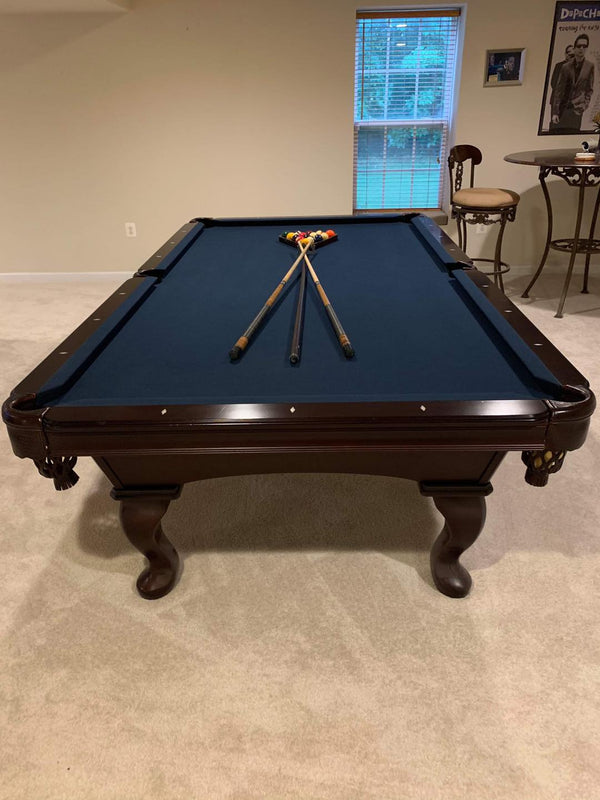
When it comes to moving or refelting a pool table, one of the most important things you need to know is the type of bed your table uses. Table bed types can vary, and knowing what you have will help you understand how we can best assist you. This guide will walk you through the common types of table beds, and how to identify them so you can confidently proceed with your table services.
1. Slate vs. Slatron
- Slate is a type of fine-grained rock used in high-quality pool tables. It provides a smooth, level playing surface and can last a lifetime. If you have a slate table, you likely have either a 1-piece or a 3-piece slate table (most common).
- Slatron, on the other hand, is a synthetic material often used in budget tables. It’s essentially a compressed particleboard with a laminate surface. While it may be cheaper, Slatron warps over time and doesn’t offer the same smooth playing experience. We don’t typically move or refelt Slatron tables due to their low durability and difficulty in achieving a smooth refelt.
How to Identify Slate vs. Slatron:
- Weight: Slate is much heavier than Slatron. If your table is difficult to move, it’s likely slate. Slatron tables are noticeably lighter.
- Feel: Slate feels cold and smooth to the touch, while Slatron has a more textured, laminate feel.
- Look Underneath: Check underneath the table. If you see what looks like a rough, natural stone surface, you have a slate table. Slatron will look more like a fiberboard or pressed wood.
2. 1-Piece vs. 3-Piece Slate
Once you know you have a slate table, the next step is figuring out whether it's a 1-piece or 3-piece slate.
- 1-Piece Slate: This type of slate is a single, large slab of stone. While we can refelt 1-piece slate tables, we don’t typically move them due to the weight and difficulty of handling a single slab.
- 3-Piece Slate: This is the most common type of slate used in higher-end pool tables. The slate is divided into three pieces, making it easier to move, level, and refelt. We move and refelt 3-piece slate tables regularly because the pieces are more manageable, and the table is easier to level during reassembly.
How to Identify 1-Piece vs. 3-Piece Slate:
- Underneath the Table: The easiest way to tell the difference is to look underneath the table. On a 1-piece slate table, you’ll see a single large slab of stone. A 3-piece slate table will have clear divisions where the slate is bolted together.
- Seam Lines: A 3-piece slate table will have visible seams where the slate pieces join together. These seams are often covered by the felt but may be felt (pun intended) by running your hand over the table's surface.
3. Wood Bed Tables
In addition to slate and Slatron, some tables use a wood bed rather than slate. These tables are typically lower-quality, and while they may look like a pool table, they can’t be leveled properly. Since wood bed tables are often made as a single piece, they are difficult to transport, and due to their low-quality materials, we don’t move or refelt wood bed tables.
How to Identify a Wood Bed Table:
- Weight: Wood bed tables are usually lighter than slate tables, though heavier than Slatron.
- Construction: The table's surface is made entirely of wood rather than stone. The wood is often thinner and less durable than slate.
- Leveling Issues: Unlike slate, wood beds warp over time, which makes it impossible to level the table accurately. This is a key reason we do not move or refelt these tables.
4. Additional Considerations
- Thickness: Most slate tables use ¾-inch or 1-inch thick slate. Thicker slate is more durable and offers a better playing experience, though it’s also heavier.
- Frame Construction: Heavier slates, especially 1-piece slate tables, require strong frames for support. If your table has a particularly sturdy, chucky frame, it’s more likely to be a 1-piece or thicker slate.
Why It Matters
Understanding your table’s bed type type helps us determine what services we can offer. We prioritize safety and efficiency, which is why we don’t typically move 1-piece slate tables, wood bed tables, and don’t work with Slatron tables. By knowing what you have, you can ensure you get the best service tailored to your pool table’s needs.
Visual Identification: Photos
Here are some photos to help you identify your slate type and beds. Pay close attention to the seams in the 3-piece slate and the differences between slate and wood beds.
Bed examples (view from underneath tabled bed)

3pc Slate Examples shown above. 1pc slate would not have the support beams underneath

Wood Bed Examples shown above

1pc slate example (commercial coin-op)
If you’re unsure about your table’s bed type, or need more assistance, feel free to reach out to us! We’re always happy to help guide you through the process.







